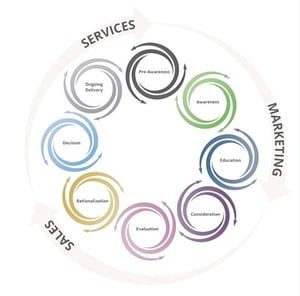
How Funnel Metrics Apply To The New Cyclonic Buyer Journey™
Buyer Behavior Has Changed So Dramatically That You Have To Forget The Old Funnel

If you don’t remember (or didn’t see) the article that introduced the new cyclonic buyer journey™, click here to check it out.
If you buy into this new thinking around the buyer journey, then you also need to start rethinking how sales and marketing execution needs to be altered to better influence prospects as they work through the chaos and cycles associated with the new model.
However, before you start with the tactics, you need to know the numbers and metrics associated with the new cyclone model, and you have to know what those are if you’re going to proactively manage your prospects’ experiences through the numerous cycles.
Here’s how to apply some of the traditional metrics to the new buyer journey.
Total Available Market
This is one of the least discussed metrics, but many would tell you it’s one of the most important. How many prospects are in your target market? This is commonly referred to as total available marketing, or the total number of companies that match your company profile. If you grabbed a reasonable percentage of those companies, would you have enough total opportunity to hit your revenue goals?
This is an important question to ask, and it’s one that a lot of companies push right past, assuming it’s a non-issue. Whether you think it’s an issue or not, it’s always good to know how many companies fit your prospect persona, and also how many of those are reasonable for you to touch and close in a defined time frame (like this year).
For this group of people, you’ll start to explore the challenges they’re facing and the trigger mechanisms that start their desire to find a solution. We commonly refer to these people as being in the pre-awareness stage. They fit the profile, but they don’t yet have the pain required for them to be looking for a solution. Or, if they do have the pain, they are still unaware that solutions exist. It’s going to be marketing’s job to move these people from unaware to aware, so they start looking for your solutions.
Measurable Awareness (Visitors To Your Website)
 Want to measure awareness? Visitors to your website are the first metric that gives you some measure of how aware your target persona is of your products and services. An old-school metric was the arbitrary brand equity.
Want to measure awareness? Visitors to your website are the first metric that gives you some measure of how aware your target persona is of your products and services. An old-school metric was the arbitrary brand equity.
How aware are people of your brand, your products, your services or your company? Today, brand equity has little to do with your revenue generation. Yes, more is better than less, but it’s hard to turn brand equity into dollars.
However, it is easy to turn visitors to your website into dollars, and it’s safe to say that the more people coming to your website, the more people are aware of your company, your products, your services and your brand.
The introduction of account-based marketing (ABM) is also going to be associated with metrics around awareness. One aspect of ABM is identification of all the accounts you want to do business with. In some cases, ABM strategy might have you segmenting these accounts into tiers, with a few selected whales at the top, a middle category with great targets that might offer less opportunity and then finally a lower level of equally qualified but even smaller revenue-producing accounts. This entire exercise would also provide metrics as to how well you’re doing with awareness.
The number of people you’ve attempted to connect with are now aware. The number of people who have actually connected are also aware. This data (plus visitors to your website) gives you a good idea of how you’re doing at this stage in your prospects’ buyer journey.
Conversion Rate: Awareness To Interest
After awareness is education. Conversion rates are an excellent measure of how well you’re doing at moving people out of the awareness cyclone and into the education cyclone. People you don’t know but who are visiting your site anonymously will come out of the shadows and identify themselves to you if they find your educational content worthwhile.
The higher your conversion rates, the more people are moving from awareness to education. Average site-wide conversion rates typically run between 1% and 3%, but we’ve had clients as high as 10%. Landing page conversion rates typically run between 20% and 40%, but we’ve had client pages turn 60% of visitors into leads.
Educational content is going to be a consistent theme in everything you do from a sales and marketing perspective. Moving prospects through one cyclone or cycle and into another is going to be done primarily with content supported by process, messaging and conversations.
The performance of individual content pieces is also going to be a solid measure of how well you're doing at influencing the buyer journey. Content that helps people make decisions, content that moves people through cycles and content that influences decision-making is going to be obvious, and data will be associated with each transaction.
Just because someone converts doesn’t mean they’re a lead. Typically, they’re considered a new contact, but depending on their behavior (like what pages they visit, how many pages they visit or what content they convert on), they might actually be a marketing-qualified lead, or a lead worth counting as part of your new buyer journey metrics. In most cases, new contacts will tell you with their online behavior if they are an MQL or not, and then you can track and nurture them accordingly.
Conversion Rate: Interest To Consideration
After enough education, your prospects are going to make some pre-purchase decisions, like to narrow the field from many options to just a few. Consideration means they’ve decided to buy and are now deciding whom to buy from.
Metrics for this stage include certain types of offers. For example, webinars or strategically designed consideration offers would provide indication that they’ve moved into consideration. To be more specific, we have an offer on our website called “10 Secret Questions To Ask Your Digital Agency Before You Hire Them.” Anyone downloading that is likely in the consideration stage.
Conversion Rate: Consideration To Evaluation
The MQL to SQL (sales-qualified leads) conversion rate is another indicator of how well your marketing is doing at influencing the move through the cycles. In most companies, moving to consideration means needing a salesperson to provide more detailed information, like pricing, company info, payment policies, references, etc.
Unprompted outreach to sales, and the number of marketing-generated sales-qualified leads (people who ask to talk to sales), is another good metric for measuring how well you’re doing at influencing your prospects to move (and move with you as opposed to your competitors).
Conversion Rate: Sales Opportunities To Rationalization Or Negotiation
 Sales-qualified leads eventually become sales opportunities, and most of the time these prospects are in the rationalization or negotiation cycle. They’ve picked a provider, solution or company, but the details of the deal are still being worked out. Contracts are exchanged, signatures are required and jobs might be on the line. Everything just got real.
Sales-qualified leads eventually become sales opportunities, and most of the time these prospects are in the rationalization or negotiation cycle. They’ve picked a provider, solution or company, but the details of the deal are still being worked out. Contracts are exchanged, signatures are required and jobs might be on the line. Everything just got real.
This is where questions get asked that should have been asked earlier. This is where questions that were asked earlier get asked again because paperwork is on the table. When did you say we could get started? What does that process look like? Who would we be working with? Can we get a different team? Give us more details on this section of your proposal. Can we negotiate a bigger discount?
If your sales process is designed well, the conversion rate of sales-qualified leads to sales opportunities should be pretty high. This conversion rate is a data point that will highlight whether you have any late-stage buyer journey process issues.
This is also going to be an indication and a measure of how effective your final paperwork is. If it’s full of legal jargon, it’s going to present a ton of friction, delays and questions. It’s going to extend your prospects’ buyer journey. If your final presentation is all about you and includes nothing about how you’re going to help your prospect, you might just get kicked out at the last stage in favor of your competitor who told a better story here. I’ve seen it happen.
Conversion Rate: Negotiation To New Customer
The true measure of this final step is the close rate on the proposals, recommendations, agreements or contracts submitted. Ideally, this should be 80% to 95%, because you’ve talked about, presented, clarified and gained consensus on almost everything in the agreement. What might mess this up so late in the journey are unexpected circumstances.
For example, the company is getting sold. No one told you because no one knew. Or perhaps the company is acquiring another business and all major projects are on hold. Again, your team might not have known and could not have clued you in. Maybe your contact at the company needs board approval, and despite your encouragement to let you speak to the board, you never gained that access. During the board presentation, the project is put on hold for unforeseen reasons. Stuff like this happens every day. But this should be the exception, not the rule.
This is also the place to start looking at the length of the sales cycle. How long did this journey take from the first click or introduction to the final approval? 30 days? 60 days? Is that number increasing, decreasing or holding steady? This is a key metric you should be intimate with, and it’s a major indicator of how effective your revenue team is at influencing your prospects’ journeys through the series of cycles or cyclones that make up today’s buyer experience.
Yes, this sounds complicated, and it is complicated. The old gravity-controlled funnel is gone. Smash it. It no longer represents the buyer journey your prospects are on, and it illustrates an old concept where you could actually move prospects down and out.
Today, you’re going to need a wide variety of strategically planned and tightly orchestrated marketing and sales tactics to influence prospects, to help them and to act as their guide while they navigate the cyclones associated with their unique and personal buyer journey.
We’ve introduced the new model, talked about the new stages and showed you the metrics associated with the new model. In an upcoming article, we’ll talk specifically about the new set of marketing and sales tactics required to provide the influence to position your company as the only choice for your prospects.
Square 2 Marketing – Revenue Is Earned Through Experience, Methodology And Insights!

CEO and Chief Revenue Scientist
Mike Lieberman, CEO and Chief Revenue Scientist
Eliminate Hit-or-Miss Marketing Moves
Get advice, tips, tools and guidance to generate more leads for your company in this weekly email newsletter.



Eliminate Hit-or-Miss Marketing Moves
Get advice, tips, tools and guidance to generate more leads for your company in this weekly email newsletter.













